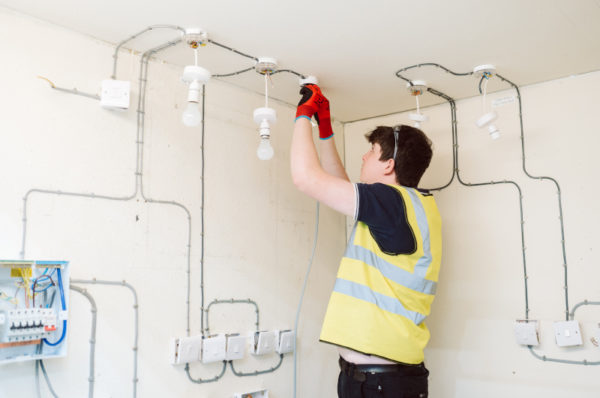
Scheme of Work
Course title: - Wire & Test
Awarding body: - EAL (Empta Awards Limited)
Location: - Room 8
Number of learners on unit: - 1- 12 absolute maximum (ideal number is 9 due to resources in room)
Aims of the unit
The course aims to introduce the learner to the basic concepts and theories of electrical engineering. The course comprises theory with practical sessions.
Paramount throughout the unit will be safety while working in an engineering environment especially with regards to the dangers of electricity.
Awareness of Asbestos will be included
Legislation and regulations are also covered being referred to periodically throughout the unit.
Regulations referred to are: -
BS 7671 17th Edition Wiring Regulations
Electricity at Work act 1989
Health & Safety at Work act 1974
COSHH: - (control of substances hazardous to health)
RIDDOR: - (Reporting of Injuries, Diseases and Dangerous)
PUWER: - (The Provision and Use of Work Equipment Regulations 1998)
Course content
(contents are derived from the requirements of the specific unit. See unit specification for details) QPEO2-033 Wire & Test.
The contents cover both industrial and domestic electrical installations and include information/tuition for both single phase and three phase supplies.
Various techniques are used to convey the information to the learners including theory, practical demonstrations and practical sessions for them to complete under guidance and feedback.
Areas within the unit include: -
Basic electrical theory, Volts, Amperes, Resistance & Power.
Types of cable used & why, such as s.w.a, p.v.c insulated & P200
Types of circuit include: -
Industrial & domestic power circuits including ‘ring’ & ‘radial’ feeding 13amp socket outlets
Industrial & domestic lighting circuits
Control circuits specifically for motor control
Motor starting, D.O.L and star delta of squirrel cage induction motor
Isolation & lock off procedures
Course structure
The unit is split into 6 weeks. The 6 weeks are laid out as follows but may be amended to suit other requirements such as meetings either company or p.d meetings etc. The
Week One
Introduction, basic electrical, stripping cable & wiring plugs, making off SWA (steel wired armour) glands.
Week Two
Power circuits feeding consumer units. Ring & radial socket outlet circuits constructed
1st assessment this week, wiring in single core, a ring circuit and testing it. Assessment includes feeding the consumer unit with SWA cable and terminating correctly.
Week Three
Lighting circuits using the ‘loop in’ method starting with one way, two way and if time permits intermediate switch wiring.
2nd assessment, wiring a two way lighting circuit using single core cable through conduit and testing it.
Week Four
Control components to aim towards building motor starter circuits. Components include:
Contactors and auxiliary blocks, timers (electromechanical & electronic), motor overloads, din rail mounted connectors, panel indicators, panel mounted push buttons.
Typical control voltages.
Basic stop/start circuit.
Adding timers to circuits
Week Five
Squirrel cage induction motor and its component parts
Motor starting.
D.O.L
Star/Delta
3rd assessment, wiring a star delta starter
Week Six
Finish off unfinished 3rd assessments and UPK questions
End of unit reports and feedback
Assessments
Assessments are carried out by getting the learner to complete 3 practical exercises and one written question paper of 34 questions (These are known as UPK or Underpinning Knowledge questions). These questions are to assess if the learner has taken on board knowledge to back up the practical knowledge gained throughout.
The practical assessments are done approximately every two weeks and relate to the recent subject being taught. The last assessment has to comprise several techniques/topics into one assessment.
The assessments are: -
Feed to consumer unit & ring main wiring & test
Two way lighting circuit wiring & testing
Wiring of a star delta panel and connecting to an industrial squirrel cage induction motor.
Feedback
Feedback to the learner is by means of verbal feedback as well as written feedback both for the training exercises and formal assessments. Individual demonstration may occur if the learner has not grasped the process after the initial demonstration usually done with the learners gathered round so they can observe the process.
After the six week period the learner will be given a report outlining the grade given in various parameters such as speed, cooperation, quality etc. If the learner gains competency in all assessments and works safely then the unit is awarded. If any part is below the minimum standard then time will be allocated to be able to repeat the section which was under achieved to be able to gain the unit. Time may also be required to give the learner further input to be able to achieve this.
Resources
Training pack
Assessment pack
Individual training task packs
A3 or X200 form to log progress/completion
Feedback forms for both practical & theory assessments.
Two A4 folders labelled ‘Evidence’ & ‘Training’
Training & assessment boards
Training
Power board for radial & ring circuits
Lighting boards for one/two way and two way & intermediate.
Control panel to construct various control circuits
Assessment
Large board for ring assessment and lighting assessment.
Panel to construct star/delta starter
Motor panel & sy cables to connect to assessment panel for motor starting.
Cable of various types such as SWA, single core, 3 core p.v.c flex.
- Teacher: Kamaldeep Singh